
views
Planning Your Ambigram

Choose a word you want to turn into an ambigram. If this is your first time attempting to create an ambigram, then choosing a word on the shorter side is a good idea. If you want to try something more advanced, pick a longer word. Longer words pose more challenges as there are simply more letters that need to be made to look like each other. A simple word to choose might be “BOOK” as it’s only 4 letters. A more advanced word would be “TELEVISION” as it has 10 letters. If you’re not sure what word to try, stick with your name.
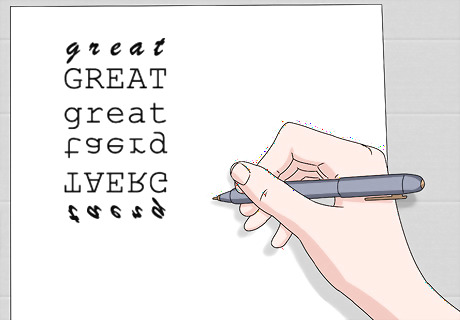
Write your word out normally, in capitals, and upside down. With a pencil, write your word down on a piece of paper as you normally would, then in all capital letters, and finally upside down (look at the example above for inspiration). Try to keep each letter directly above the other, as this will make the next step easier. For example, if your word was “great,” write it out on a piece of paper and then directly below it, write “ʇɐǝɹƃ” lined up letter-for-letter with the normal spelling. If you’re feeling fancy, write the word in cursive letters to make a more advanced ambigram. Not sure how to write your word upside down? Use an online Word Flipper for help.
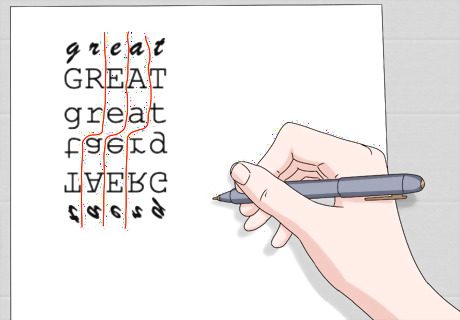
Connect the letters of the words with lines. Look at the letters in the words like columns, dividing each letter with a parallel line. Doing this allows you to pair up the letters and visualize what each letter needs to transform into when you look at the word from a different perspective. Use the example above to guide you. For example, for the word “great,” connect “gr” with “t,” then “e” with “a,” then “a” with “e.”

Decide whether any letters need to be combined into one. While this is a more advanced skill, combining letters can make the ambigram more artistic. Stick with just pairing individual letters up together to keep it simple. For instance, in the word “great,” the letter “g” pairs with “t,” as these are the first and last letters. If you wanted to combine the letters, you might make it so the letter “g” pairs up with the letters “a” and “t.” This would mean the letter “g” will turn into “at” when viewed from an alternative angle because “a” and “t” are combined. Combining letters is a bit more complicated, so if you're just starting out, skip this step and stick to transforming 1 letter at a time.
Drawing the Ambigram
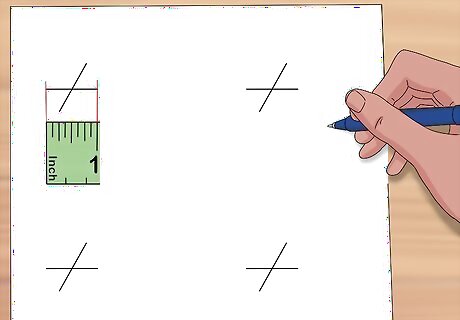
Draw 4 sets of horizontal parallel lines about 1 inch (2.5 cm) wide. Position these anywhere on your paper or work surface. If you’re using lined paper, use the lines in the paper as a guide. Take a look at the image above for a visual example. While this step isn’t necessary, it can help give you a clear idea of where you’ll sketch your letters. You can draw as many of these lines as you want, but 4 is a good starting point.
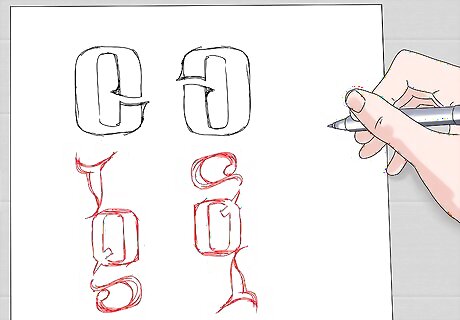
Sketch your letters individually on a separate piece of paper. Now it’s time to brainstorm! How do you want your letters to look on the page stylistically? Try different shapes and exaggerating different features of the letters to make them look more like their pair. For example, you might exaggerate the curve on an “e” to make it look more like an “o.” Another example may be that you play with the curve of the tails on letters like “g” and “q.” This is where the creative portion of the ambigram starts to come through, so don’t be afraid to be artistic! Not sure what to sketch? Type your word into a word processor and change its font. Then, use the different versions of the word as inspiration.

Draw the ambigram in a rough sketch by combining your letters. Transfer or copy your sketches of each letter on top of the 4 parallel lines you made previously. Place the upside-down and right-side-up versions of the letters next to each other. This doesn’t have to be perfect, but try and combine your letters to form the word. For example, if your word is “great,” combine the individual letters to form the whole word. Ideally, an ambigram looks like it’s been written with all of the same font rather than each letter having its own individual style. Combining the letters here allows you to check that out and make adjustments.
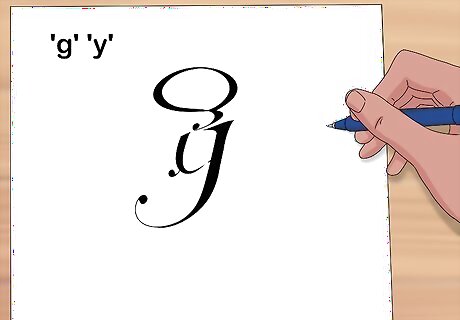
Refine the ambigram with decoration. Once you’ve checked how the ambigram flows and blends, you can add even more flair to it. Try accentuating the tails and features of letters, as you often see in ornate styles of writing such as calligraphy. For example, you may decorate the curve of the tails on a “g” or a “y” as is the case in calligraphy and other styles.

Check that the ambigram reads from both of the intended views. Once you have a full sketch of the word, take a look at the piece of art you’ve created. Flip the paper around to all possible reading angles—can you read the word from the top and bottom? If so, you’ve successfully made an ambigram! If not, no worries. Start a new sketch or use an eraser to fix any mistakes. Once you’re happy with your design, trace over it with a pen or marker to add more depth or permanent details.




















Comments
0 comment